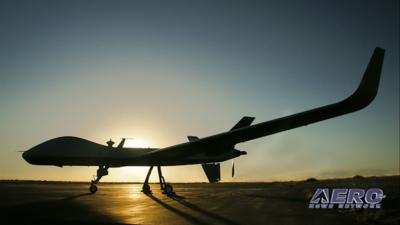Thu, Aug 29, 2019
GBSAA COA Decreases Cost Of RPA Flight Operations
The FAA has granted a Certificate of Waiver or Authorization (COA) to General Atomics Aeronautical Systems, Inc. (GA-ASI) for Beyond Visual Line of Sight (BVLOS) operations by utilizing a Ground-based Sense and Avoid (GBSAA) system. The GBSAA system provides an alternative to using a more costly and operationally restrictive chase aircraft.

“Thanks to the support of Senator Hoeven and Grand Forks Air Force Base, GA-ASI will be able to use GBSAA as an alternate and preferred means of compliance,” said David R. Alexander, president, GA-ASI. “This COA will open the skies for more unmanned flights around our North Dakota facility and establish North Dakota as a UAS Training Site of Excellence for the Global Customers.”
The Northern Plains UAS Test Site paved the way for attaining the first Public COA that incorporates the Grand Forks Air Force Base Air Surveillance Radar (ASR)-11 and the L3Harris Technologies VueStation and RangeVue systems to meet “see and avoid” requirements for a significant volume of airspace. The replication to a civil COA enables BVLOS flights to be conducted out of GA-ASI's Flight Test and Training Center (FTTC) located in the Grand Sky Unmanned Aircraft System (UAS) Business Park near Grand Forks, North Dakota. The FAA authorization has been granted for one year beginning on August 31.
“This is a big step that will help us to advance UAS operations and comes as the result of our work to both fund the DASR-11 radar and secure authorization from the FAA. Requiring a visual observer adds significant cost and complications to UAS operations and limits the ability of General Atomics, Grand Sky, the test site and others to develop this technology, which is why we’ve been working closely with the FAA to allow broader permission for BVLOS flights,” said Senator Hoeven. “By relying on the DASR-11 radar we secured for the Grand Forks Air Force Base, as well as other sense and avoid technologies, General Atomics will be able to fly UAS without an observer or chase plane up to 60 miles from the air base. This is a significant expansion of the company’s unmanned operations in the state, another important step toward safely integrating this technology into our airspace and further proof that North Dakota is the location of choice for UAS research, development,
testing and operations.”
The civil COA authorizes GA-ASI to conduct GBSAA flight operations using its company-owned Predator B Remotely Piloted Aircraft (RPA) within 60 nautical miles of the FTTC.
(Source: GA-ASI news release. Image from file)
More News
Light Gun A handheld directional light signaling device which emits a brilliant narrow beam of white, green, or red light as selected by the tower controller. The color and type of>[...]
“We have performed extensive ground testing by comparing warm up times, full power tethered pulls, and overall temperatures in 100 degree environments against other aircraft >[...]
While Taxiing To Parking The Right Landing Gear Leg Collapsed, Resulting In Substantial Damage Analysis: The pilot made a normal approach with full flaps and landed on the runway. >[...]
From 2014 (YouTube Edition): Exotic Rebuild Reveals Aerial Work Of Art During EAA AirVenture 2014, ANN's Michael Maya Charles took the time to get a history lesson about a great ai>[...]
Also: Project Talon, McFarlane Acquisition, Sky-Tec Service, JPL Earth Helo Tests Bombardier has earned a round of applause from the business aviation community, celebrating the fo>[...]
 ANN's Daily Aero-Term (12.13.25): Light Gun
ANN's Daily Aero-Term (12.13.25): Light Gun Aero-News: Quote of the Day (12.13.25)
Aero-News: Quote of the Day (12.13.25) NTSB Final Report: Gippsland GA-8
NTSB Final Report: Gippsland GA-8 Classic Aero-TV: Historically Unique -- Marlin Horst's Exquisite Fairchild 71
Classic Aero-TV: Historically Unique -- Marlin Horst's Exquisite Fairchild 71 Airborne 12.12.25: Global 8000, Korea Pilot Honors, AV-30 Update
Airborne 12.12.25: Global 8000, Korea Pilot Honors, AV-30 Update



